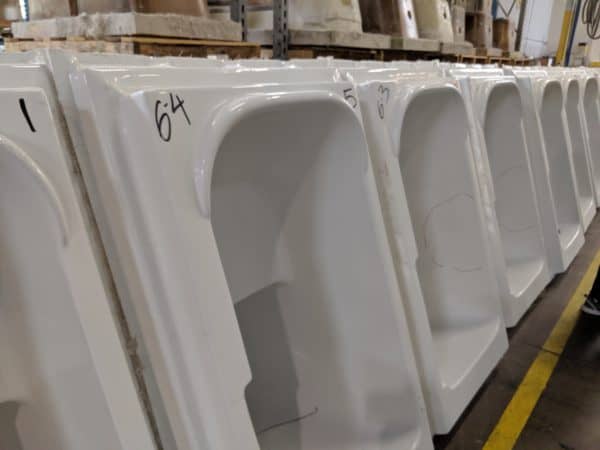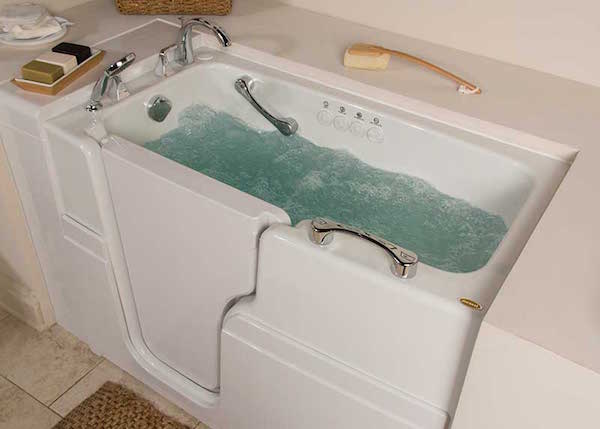Will Medicare Pay for a Walk-In Tub?
Does Medicare Cover Walk-in Bathtubs?
As of 2025, Medicare will not cover the cost of a walk-in tub, as they are not considered durable medical equipment.
Examples of durable medical equipment (DME) include wheelchairs, walkers, and oxygen concentrators. Because anyone can benefit from a walk-in tub, even those who aren’t disabled, Medicare doesn’t include it in their list of DME, meaning Medicare usually won’t cover the cost of the walk-in tub or tub installation.
Our Top-Rated Walk-In Tub Brands
If you’re exploring Medicare coverage for a walk-in tub, it’s important to understand that no single model is perfect for everyone, but we’ve identified three brands that consistently offer the best overall value. These brands provide a range of models tailored to fit various bathroom layouts, making it easier to find an option that aligns with your needs and coverage considerations.
An Exception to The Rule
With that being said, in rare cases, Medicare will reimburse older adults for their walk-in bathtub. However, there is a process to get the reimbursement.
For Medicare to consider reimbursement, you must have a medical prescription from a healthcare provider. The prescription needs to include exactly why you need the walk-in tub and what features you need with it.

For example, I had a client who needed a leg amputated, meaning he could no longer climb into a tub without assistance. This client got a prescription from his primary healthcare physician for a walk-in bathtub, which allowed him to install the tub and receive subsequent reimbursement from Medicare.
Still, he didn’t need one with all the bells and whistles, such as air jets or whirlpool features. Rather, he needed a basic bathtub with a door to get in and out. Medicare will make you prove why you need the extra features, so keep this in mind when picking out the tub.
It’s also important to note, Medicare does not pay upfront for the tub. Instead, they compensate in the form of a reimbursement and the reimbursement isn’t guaranteed. There have been times when clients of mine think they could get reimbursed, but once they submit their reimbursement claim, Medicare denied it, and they were stuck paying for the walk-in tub out of pocket.
FYI: Although a prescription does not guarantee reimbursement from Medicare, failure to obtain one ensures that you won’t receive reimbursement.
Financial Assistance for Walk-In Bathtubs
Although Medicare doesn’t traditionally cover walk-in bathtubs, there are other means of financial assistance for walk-in baths.

- Medicaid will sometimes cover some or all the cost of a walk-in bathtub. Medicaid is not a single federal program; rather, each state has many different Medicaid programs, some of which may cover walk-in bathtubs.For example, I had a client in California who was able to get coverage because of a program that helps nursing home residents transition back to their homes. Some states also have programs specifically for home and community-based services, and these programs will also sometimes cover specialized medical equipment like walk-in tubs.About 30 different states offer community transition funds like these, and they’re one of your best bets towards funding a walk-in tub. Before buying a walk-in bathtub, you should check what Medicaid covers in your particular area.
- Veterans Assistance can also aid in the purchase of a walk-in tub. However, financial aid for veterans is more likely to come in the form of a grant than from VA insurance. For those vets who have coverage through TRICARE or CHAMPVA insurance programs, the chances of getting help with a walk-in tub are slim.Home modification grants for veterans are a very real option for those who require a walk-in bathtub. Some of the grants available to aging vets aren’t tied to military service, meaning a veteran who requires medical devices as a result of aging could get some financial aid. Again, like with Medicare and Medicaid, this isn’t a blanket rule, so before buying a walk-in bathtub, you want to make sure you are eligible for the grant.
- The United States Department of Agriculture offers grant opportunities that may be applied to walk-in tubs. In particular, the USDA Rural Repair and Rehabilitation Grants provide loans to low-income aging adults who live in rural areas.Those eligible can apply for these loans, and the money can go to improving homes and making modifications to improve safety and remove hazards. You would be able to buy a walk-in bathtub under this grant because the tub removes the risk of slipping while stepping into a tub. And with bathrooms considered one of the most dangerous rooms in the house for older adults because of slipping, a walk-in tub can certainly prove essential.
- Private Insurance can sometimes cover some costs of walk-in tubs; however, much like Medicare, this will usually require a prescription for a doctor. While each private insurer will treat this issue differently, they’ll generally steer you to lower cost options such as basic tubs or walk-in showers, which require less intensive installation and costs.
- Payment Plans, while not exactly offsetting the costs of a walk-in tub, can certainly make this renovation more accessible. Walk-in tubs are one of the more expensive home modifications, costing approximately $2,000 to $10,000 with the installation. Because of the steep price points, some companies will offer payment plans.When you’re shopping for walk-in tubs, I suggest asking the sales associate or customer service representative about payment plans. But before agreeing to any plan, make sure you read the fine print so you know exactly how much you will have to pay, how often, and for how long.
Did You Know: Medicaid offers different program options depending on the state you live in, and some of those programs will cover either part of all of a walk-in bathtub expense. However, you must do your research before buying a tub to make sure you’re eligible for assistance.
Alternatives to Walk-In Bathtubs
If the price of a walk-in bathtub is too much to bear, then here are alternative modifications that can make your bathroom a safer place. Here are some other options to consider:
- Bathtub Transfer Bench: This mobility device provides a place for you to sit while getting into your existing tub. The bench straddles the side of the tub and gradually slides from the outside to the inside of the tub while you sit on it. There are many different types of benches on the market and they usually cost between $45 and $300, a much more affordable option than a walk-in bathtub.
- Bathtub Chairs: This product works similarly to the bathtub bench but is smaller and sits fully inside the bathtub. To use this, you sit on the chair and swing each leg into the tub. This is not as easy to use as the bench, so it’s not a great option for everyone as there is still a chance you can fall. However, it’s pretty cheap compared to other options, with a price tag between $20 and $100.
- Bath Chairlift: A bath chairlift is a battery-operated lift that lowers you into the tub. There is a battery pack for charging between uses and is considered a piece of durable medical equipment. Therefore, if a chairlift is prescribed by a physician, there is a good chance Medicare will cover it for you. If Medicare doesn’t cover it, chairlifts are a little pricier than other alternatives, coming in anywhere from $400 to $1,000.
- Roll-In Shower: A roll-in shower is a shower that has no barriers. That means the floor of the shower is flush to the bathroom floor. There are no raised lips, so a person in a wheelchair could easily get themselves in and out. Some roll-in showers include a chair and grab bar, which start at around $2,000 for the products and installation.
- Grab Bar: Grab bars are an inexpensive solution that will help prevent slips in the shower or bathtub. However, they aren’t very helpful when it comes to getting into the tub unless you are able to reach the bar from the outside and hold onto it as a support while you climb in. Therefore, they are best used as a backup to one of the other walk-in tub alternatives. Grab bars cost about $25 and you can easily install them by yourself or with the help of a loved one or handyman.
Final Thoughts
While walk-in bathtubs are a nice perk for aging at home, they are a more expensive undertaking and they usually aren’t covered by Medicare. Therefore, if you decide on getting a walk-in tub, you will need to budget accordingly, as most likely you’ll be paying out of your pocket.
To see some our favorite brands, check our list of the best walk-in tubs.



